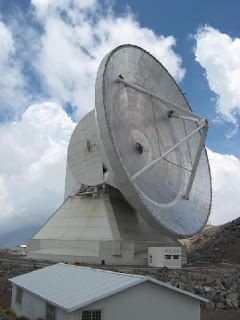
A very interesting talk will be presented next week. Please drop by and join the conversation.
6:00 PM, Wednesday, 24 February
Remote Sensing of the Geospace Environment Using Active and Passive Radio Techniques
Dr. Frank D. Lind, Research Engineer, MIT Haystack Observatory
The Geospace environment of the Earth extends from the upper atmosphere and ionosphere to the boundary between the Earth's magnetic field and the solar wind. This is a region of space plasma physics and is largely invisible to the naked eye with the exception of energetic phenomena such as the Aurora. The Heliosphere which extends above this region is dominated by the influence of the Sun and solar variations play a major role in driving Geospace phenomena. At the lower boundary of Geospace the coupling to the neutral atmosphere of the Earth and terrestrial weather and processes are increasingly recognized as having a strong role in some Geospace phenomena. The different regions of Geospace are coupled by physical processes which transfer energy and momentum across many spatial scales and time spans. Persistent features such as the Aurora, radiation belts, and ubiquitous waves and tides are also punctuated by dramatic events such as geomagnetic storms which are created by the Sun. The Geospace environment is global in nature and hosts significant and wide ranging changes on timescales ranging from seconds to decades (and beyond). These changes greatly influence radio wave propagation, absorption, and scattering, and also produce significant changes in the population and structure of energetic particles surrounding the Earth. The many phenomena which interact in the Geospace environment produce a range of Space Weather effects which can be of practical importance to technological society and systems.
I will discuss radio remote sensing of the Geospace environment using radar and radio techniques and describe how radio wave propagation and scattering allows us to make fundamental physical measurements of this region. To motivate this discussion I will provide a basic overview of radio propagation in the space environment and discuss the more fundamental plasma modes and wave instabilities which exist. I will then describe the process of radar remote sensing using incoherent and coherent scattering from these space plasmas and how the scattering physics allows us to extract fundamental physical parameters. I will also discuss measurements which observe the scintillation and phase variation of radio signals from stellar radio sources as well as satellite borne radio beacons such as the Global Positioning System (GPS) constellation.
As part of this discussion I will make an effort to place these techniques in their historical context, provide an overview of the Geospace environment, describe the strong influence of the Sun, and discuss the major physical phenomena which are observed. I will also provide examples of the current generation of radar and radio instrumentation used to make these measurements including incoherent scatter radars, passive radars, and ground based radio arrays. I will provide examples of how these instruments enable the detection, visualization, and detailed investigation of the physics of the Geospace environment. As time allows I will provide additional details on the Space Weather impacts of the Geospace environment and discuss the next generation of instrumentation which has been enabled by advances in radio array technology.
Dr. Frank D. Lind is a Research Engineer with MIT Haystack Observatory where he has worked for the past decade to design, implement, and operate radio science instrumentation. He is one of the principal investigators for the National Science Foundation's Millstone Hill Facility which is part of the Upper Atmosphere Facilities program. In this role he acts as the lead engineer for the Facility whose major instrument is the Millstone Hill UHF radar system. This high power large aperture radar system is used to make detailed physical measurements of the Geospace environment and has been a key instrument used in many NSF, NASA, and DoD supported investigations. His research focuses on the development of radio science instrumentation, Software Radar techniques, space plasma physics, and distributed radio array technology and applications. Dr. Lind studied at the University of Washington where he received a Bachelor of Science degree in Physics and a Bachelor of Science degree in Computer Science in 1994. He then joined the UW Geophysics Program and pursued studies leading to the Doctor of Philosophy in Geophysics in 1999. His work there focused on Passive Radar observations of the Aurora Borealis. He is currently the chair of USNC URSI Commission G (United States National Committee of the International Union of Radio Science), a member of the American Geophysical Union (AGU), and a member of the IEEE.
The meeting will be held at the MIT Lincoln Laboratory Cafeteria in Lexington, MA. Refreshments will be served at 5:30; the talk will begin at 6:00 pm. The talk is open to the general public.
Directions to Lincoln Laboratory Cafeteria from points north: Take I-95/128 south to exit 31B, Routes 4 & 225 towards Bedford. Stay in right lane and use the right turning lane (0.3 miles) to access Hartwell Ave at first traffic light. Follow Hartwell Ave to the end; take a left onto Wood Street (just before the AFB gate). Lincoln Laboratory entrance is 0.5 miles on right. The entrance to the cafeteria is on the lower level left of the main entrance.
From points south: Take I-95/128 north to exit 30B, Route 2A west. Turn right on to Mass Ave (~0.4 miles). Turn left on to Wood Street (~0.4 miles) Lincoln Laboratory Wood Street entrance is 1 mile on left. The entrance to the cafeteria is on the lower level to the left of the main entrance.



